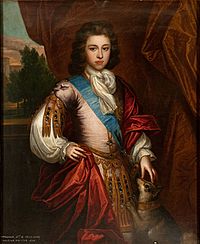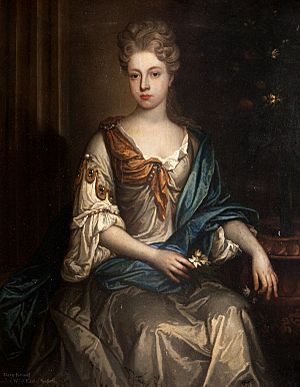William Mackenzie, 5th Earl of Seaforth facts for kids
Quick facts for kids
William Mackenzie, 5th Earl of Seaforth
|
|
|---|---|

Seaforth as a boy
|
|
| Born | Unknown |
| Died | 8 January 1740 Isle of Lewis |
| Title | Earl of Seaforth |
| Tenure | 1701–1716 (Attainted) |
| Nationality | Scottish |
| Spouse(s) |
Mary Kennet
(m. 1715) |
| Issue | Kenneth Mackenzie, Lord Fortrose The Hon. Ronald Mackenzie The Hon. Nicholas Mackenzie Lady Frances Mackenzie |
| Parents | Kenneth Mackenzie, 4th Earl of Seaforth Lady Frances Herbert |
|
|
|
William Mackenzie, 5th Earl of Seaforth (died 1740), was a Scottish nobleman and the leader of Clan Mackenzie. He was also known as Uilleam Dubh or Black William. William was educated in France and grew up as a Roman Catholic.
He was involved in the Jacobite Rising of 1715 and the 1719 Rising. These were attempts to put a different king on the throne of Great Britain. Because of his actions, his titles and lands were taken away, a process called being attainted. He was later pardoned in 1726 and allowed to return home. However, he never got his title of Earl of Seaforth back. William Mackenzie died on January 8, 1740, on the Isle of Lewis. He was buried in the old church of Ui.
Early Life of William Mackenzie
William Mackenzie was the oldest son of Kenneth Mackenzie, 4th Earl of Seaforth. His father became a Catholic, supposedly for money from King James II. William's mother, Frances, was the daughter of William Herbert. Her father was one of five Catholic lords wrongly accused of plotting against King Charles II. This was part of a false story known as the Popish Plot.
We don't know exactly when or where William was born. His father had to leave Scotland after the Glorious Revolution in 1688. This event changed who was king. His father took part in a Jacobite campaign in 1690 but later gave up. He spent many years in and out of prison and died in 1701. He left behind many debts. William's mother sent him and his sister to France to be educated as Catholics.
William married Mary Kennett in 1713 or 1714. Mary was the daughter of Nicholas Kennett. She was also educated in France by Jesuits, a Catholic religious order.
William's Role in the Jacobite Risings
Soon after King George I became king in 1714, William was told to stay at his home, Brahan Castle. In 1715, he went to a meeting organized by John Erskine. At this meeting in Braemar, the flag of the Pretender was raised. The Pretender was the person the Jacobites wanted to be king.
William led over three thousand men, including members of the Macdonalds and Rosses clans. In October, he marched to join Mar's forces in Perth. John Gordon tried to stop him. But when William attacked, Gordon's forces retreated. William's men took goods from the area as they continued their march south. He was present at the battle of Sheriffmuir.
After the battle, the Pretender made William a lieutenant-general. He was put in charge of the northern counties. William went north to try and take back Inverness. This town had been captured by government forces. Even with help from Alexander Gordon, William could not gather enough men. He could not defeat the Earl of Sutherland's forces. So, William and his allies surrendered.
William then went to the Isle of Lewis. He tried to gather his supporters there. But when government troops were sent after him, he escaped to Ross-shire. From there, he sailed to France, arriving in February 1716. On May 7, Parliament declared him attainted. This meant his titles were taken away and his lands were seized by the government.
Later Life and Pardon
William Mackenzie also joined the Earl Marischal on his trip to the western highlands in 1719. He was badly hurt at the battle of Glenshiel on June 10. However, his followers carried him onto a ship. He escaped to the Western Isles and then returned to France.
Even though his lands were taken, his followers still sent him money while he was in exile. After a law was passed in 1725 to disarm people, his followers agreed to give up their weapons. They also agreed to pay rent to the government. In return, they asked to be excused from any past debts. A general named Wade agreed to this. He also promised to help William get a pardon.
Wade's efforts to help William were successful, even though some people like John Campbell, second duke of Argyll strongly opposed it. On June 12, 1726, William was pardoned. This meant he was free from the legal punishments of being attainted. However, he did not get his title back. King George II also gave him money from old taxes owed to the crown from his former lands.
William decided to make peace with the government partly because he was unhappy with how the Pretender treated him. He told the Pretender that he accepted the government's terms to protect his clan. But the Pretender was very upset, feeling that William had abandoned his cause. William Mackenzie died on January 8, 1740, on the Isle of Lewis. He was buried in the chapel of Ui there.


